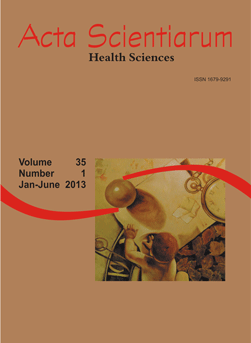<b>Social indicators and self-reported health of elderly diabetic people: variations between the sexes</b> - doi: 10.4025/actascihealthsci.v35i1.10315
Keywords:
aged, diabetes mellitus, nursing
Abstract
Diabetes has a high morbidity and mortality, with significant loss in the elderly people’s life quality. Variations between the sexes with regard to social indicators and self-reported health status of elderly people with diabetics are investigated. Current exploratory study has been undertaken at the outpatient endocrinology clinic of the University Hospital of UFPB, through interviews with 53 elderly people, of whom 38% were males and 62% were females, between October and December 2009, and data were analyzed by SPSS. Most of the elderly people (58.49%) interviewed were within the 60 - 64 age bracket. Although 71.70% reported being married, a high widowhood rate (21.21%) among the females was reported. Pension was the main source of income for 80% of males and for 54.55% of females. Whereas 42.42% of the females worked only at home, 65% of the males were unemployed. Further, 81.13% of the elderly had two or more diseases, 5% of males admitted lack of help in health care, and more men (10%) than women used assistance technologies. Since current study contributed towards a broadening of social and health indication data on men and women with diabetes, it may be beneficent towards better care in nursing.
Downloads
Download data is not yet available.
Published
2012-10-31
How to Cite
Fernandes, M. da G. M., Macêdo-Costa, K. N. de F., Moreira, M. E. de A., & Oliveira, J. dos S. (2012). <b>Social indicators and self-reported health of elderly diabetic people: variations between the sexes</b> - doi: 10.4025/actascihealthsci.v35i1.10315. Acta Scientiarum. Health Sciences, 35(1), 59-66. https://doi.org/10.4025/actascihealthsci.v35i1.10315
Issue
Section
Nursing
DECLARATION OF ORIGINALITY AND COPYRIGHTS
I Declare that current article is original and has not been submitted for publication, in part or in whole, to any other national or international journal.
The copyrights belong exclusively to the authors. Published content is licensed under Creative Commons Attribution 4.0 (CC BY 4.0) guidelines, which allows sharing (copy and distribution of the material in any medium or format) and adaptation (remix, transform, and build upon the material) for any purpose, even commercially, under the terms of attribution.
Read this link for further information on how to use CC BY 4.0 properly.























5.png)







